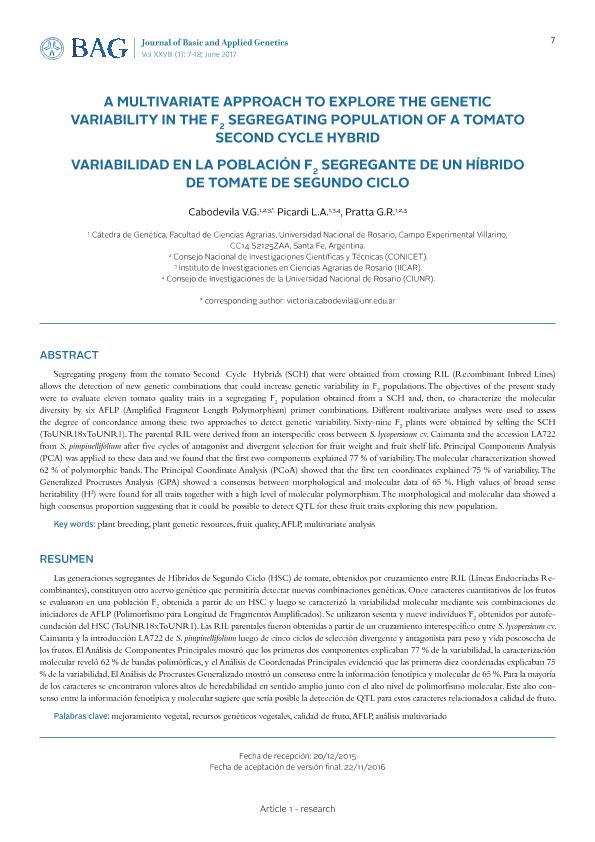Artículo
Las generaciones segregantes de Híbridos de Segundo Ciclo (HSC) de tomate, obtenidos por cruzamiento entre RIL (Líneas Endocriadas Recombinantes), constituyen otro acervo genético que permitiría detectar nuevas combinaciones genéticas. Once caracteres cuantitativos de los frutos se evaluaron en una población F2 obtenida a partir de un HSC y luego se caracterizó la variabilidad molecular mediante seis combinaciones de iniciadores de AFLP (Polimorfismo para Longitud de Fragmentos Amplificados). Se utilizaron sesenta y nueve individuos F2 obtenidos por autofecundación del HSC (ToUNR18xToUNR1). Las RIL parentales fueron obtenidas a partir de un cruzamiento interespecífico entre S. lycopersicum cv. Caimanta y la introducción LA722 de S. pimpinellifolium luego de cinco ciclos de selección divergente y antagonista para peso y vida poscosecha de los frutos. El Análisis de Componentes Principales mostró que los primeros dos componentes explicaban 77 % de la variabilidad, la caracterización molecular reveló 62 % de bandas polimórficas, y el Análisis de Coordenadas Principales evidenció que las primeras diez coordenadas explicaban 75 % de la variabilidad. El Análisis de Procrustes Generalizado mostró un consenso entre la información fenotípica y molecular de 65 %. Para la mayoría de los caracteres se encontraron valores altos de heredabilidad en sentido amplio junto con el alto nivel de polimorfismo molecular. Este alto consenso entre la información fenotípica y molecular sugiere que sería posible la detección de QTL para estos caracteres relacionados a calidad de fruto. Segregating progeny from the tomato Second Cycle Hybrids (SCH) that were obtained from crossing RIL (Recombinant Inbred Lines) allows the detection of new genetic combinations that could increase genetic variability in F2 populations. The objectives of the present study were to evaluate eleven tomato quality traits in a segregating F2 population obtained from a SCH and, then, to characterize the molecular diversity by six AFLP (Amplified Fragment Length Polymorphism) primer combinations. Different multivariate analyses were used to assess the degree of concordance among these two approaches to detect genetic variability. Sixty-nine F2 plants were obtained by selfing the SCH (ToUNR18xToUNR1). The parental RIL were derived from an interspecific cross between S. lycopersicum cv. Caimanta and the accession LA722 from S. pimpinellifolium after five cycles of antagonist and divergent selection for fruit weight and fruit shelf life. Principal Components Analysis (PCA) was applied to these data and we found that the first two components explained 77 % of variability. The molecular characterization showed 62 % of polymorphic bands. The Principal Coordinate Analysis (PCoA) showed that the first ten coordinates explained 75 % of variability. The Generalized Procrustes Analysis (GPA) showed a consensus between morphological and molecular data of 65 %. High values of broad sense heritability (H2 ) were found for all traits together with a high level of molecular polymorphism. The morphological and molecular data showed a high consensus proportion suggesting that it could be possible to detect QTL for these fruit traits exploring this new population.
A multivariate approach to explore the genetic variability in the F2 segregating population of a tomato second cycle hybrid
Título:
Variabilidad en la población F2 segregante de un híbrido de tomate de segundo ciclo
Fecha de publicación:
11/2017
Editorial:
Sociedad Argentina de Genética
Revista:
Journal of Basic and Applied Genetics
e-ISSN:
1852-6233
Idioma:
Inglés
Tipo de recurso:
Artículo publicado
Clasificación temática:
Resumen
Archivos asociados
Licencia
Identificadores
Colecciones
Articulos(IICAR)
Articulos de INST. DE INVESTIGACIONES EN CIENCIAS AGRARIAS DE ROSARIO
Articulos de INST. DE INVESTIGACIONES EN CIENCIAS AGRARIAS DE ROSARIO
Citación
Cabodevila, Victoria Guadalupe; Picardi, Liliana Amelia; Pratta, Guillermo Raúl; A multivariate approach to explore the genetic variability in the F2 segregating population of a tomato second cycle hybrid; Sociedad Argentina de Genética; Journal of Basic and Applied Genetics; 28; 1; 11-2017; 7-18
Compartir




